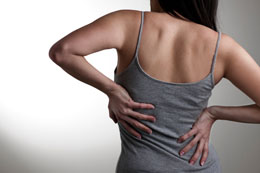Muscle spasm is a painful experience, which results from sudden contraction of the muscle(s). The common causes of muscle spasms in the back include muscle overstraining, muscle inflammation, wrong posture, dehydration, low electrolytes, drug side effects, and underlying diseases.

Muscle spasm refers to the sudden and involuntary contraction of a single muscle or a group of muscles. An abrupt increase of energy in the muscles can also result in spasms. It is actually a natural body response to protect movement of already injured muscles by limiting further movements. Though each and every muscle of the body is prone to contraction, the primary areas where painful spasms usually occur are the neck and back. During these spasms, you will feel a sudden tightness or stiffening in the affected area. Muscle spasms often resolve quickly, usually within a few minutes, but are quite painful.
Causes of Muscle Spasms in the Back
In general, muscular contraction can be caused due to various reasons, each of which is related to the predisposing factors. Muscle spasm in the back results due to inflammation and soreness of the muscle, which are caused by sudden bending or an abrupt movement. In fact, any bodily movement that is not in a correct angle can lead to muscle pain in the back. Following is a list of the possible causes of muscle spasms in the back portion.
- A common cause is over-straining of the muscles while performing household activities or physical exercises.
- Lifting very heavy objects may excite the back muscles, which are not prepared for movement, thus resulting in muscle spasms.
- A wrong posture while standing, sitting, or sleeping can also lead to painful spasms in back.
- Lack of lubrication or conditioning of the muscles is also a possible cause of back muscle spasm.
- Deficiency of mineral nutrients, particularly calcium and potassium, results in a low electrolyte level in the body, which in turn causes painful muscle spasms in the back area.
- At times, back muscle spasms can be a result of excess dose of prescription drugs and/or side effects of strong medications.
- For women, it occurs most often during the menstrual cycle and pregnancy.
In addition to the above causes, back muscle spasms can be an indication of underlying health conditions such as muscle fatigue, damage of the nerves, spinal cord injury, physical trauma, and multiple sclerosis. Even if a single muscle is affected by sudden movement, the adjacent muscles get disturbed, thus resulting in severe back pain.
How to Stop Muscle Spasms in the Back
Muscle spasm in back is quite annoying and uncomfortable. With severe muscle pain in the back, it feels very painful to perform even the normal day-to-day activities. Millions of people worldwide seek medical attention for relieving back pain, especially in the lower portion. Regarding treatment, over-the-counter pain killers can be administered to combat pain symptoms. Nevertheless, there are certain remedial measures, which can be practiced in order to stop back spasms.
Take Rest: Proper rest is the most effective method to speed up the healing process of the injured and inflamed muscles. By taking adequate rest, the affected muscles are immobilized, which helps prevent further stressing of the injured muscles. This allows the affected muscles to recover effectively.
Stretching Exercises: Back exercises that focus on muscle stretching are effectual to break the tightened muscles. Thus, performing stretching exercises that involve the tightened muscles will help in stopping muscle spasms.
Ice Packs and Heat: Another method to temporarily stop muscle spasm in the back, is applying ice packs and heat alternatively over the affected area. Doing so will numb the area giving back pain relief.
In case of severe muscle spasms, it is always advisable to consult and seek advice from a qualified physician. Some people prefer following alternative treatment methods like massage therapy, aromatherapy, and acupressure to combat the painful symptoms.
Disclaimer: This Buzzle article is for informative purposes only, and should not be used as a replacement for expert medical advice.


 Muscle spasm refers to the sudden and involuntary contraction of a single muscle or a group of muscles. An abrupt increase of energy in the muscles can also result in spasms. It is actually a natural body response to protect movement of already injured muscles by limiting further movements. Though each and every muscle of the body is prone to contraction, the primary areas where painful spasms usually occur are the neck and back. During these spasms, you will feel a sudden tightness or stiffening in the affected area. Muscle spasms often resolve quickly, usually within a few minutes, but are quite painful.
Muscle spasm refers to the sudden and involuntary contraction of a single muscle or a group of muscles. An abrupt increase of energy in the muscles can also result in spasms. It is actually a natural body response to protect movement of already injured muscles by limiting further movements. Though each and every muscle of the body is prone to contraction, the primary areas where painful spasms usually occur are the neck and back. During these spasms, you will feel a sudden tightness or stiffening in the affected area. Muscle spasms often resolve quickly, usually within a few minutes, but are quite painful.